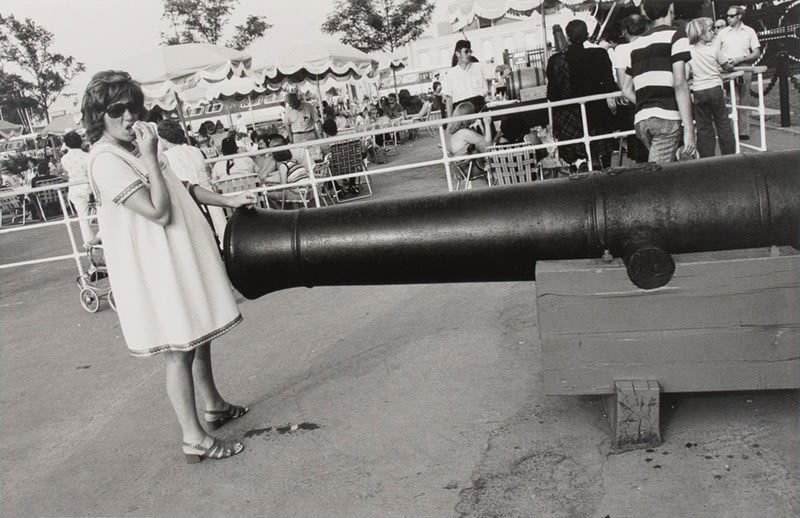
Tom Gibson
Pregnant Woman at the end of a Cannon, Toronto by Tom Gibson
 Toronto, ON)
Toronto, ON)
Learn about our Shipping & Returns policy.
Have a question? Read our FAQ.
- Artwork Info
- About the Artist
1972
Gelatin silver print
Signed, in ink, au recto
Signed, titled, dated, and annotated, in pencil, au verso
Printed circa 1972-
Initially a painter, Tom Gibson (1030-2021) later pursued photography, and was instrumental in setting up the photography department at Concordia University. Working with fellow photographer and lifelong friend Gabor Szilasi, among many others, he was influential as an artist and teacher. His work is found in galleries and collections across the country and abroad, including the National Gallery of Canada, the Canadian Museum of Contemporary Photography, the International Museum of Photography at George Eastman House (Rochester, New York) and the Art Gallery of Ontario. Tom was born in Edinburgh on December 11, 1930, and spent his teenage years in the Scottish Merchant Navy, as a marine engineer and radio operator, travelling extensively throughout the Middle East and Africa. When his 5-year contract expired, he and some friends departed for Canada, where he spent most of his adult life - living first in Toronto, then moving to Montréal in the mid 1970s.
In Toronto, through friend and artist Bob Cowan, Tom was introduced to Av Isaacs, owner of a framing shop which eventually became the prestigious Av Isaacs Gallery. Through the gallery he met future art stars, Graham Coughtry, Michael Snow, and Gordon Rayner. At that time, Tom was studying painting with fellow countryman Jock MacDonald at the Ontario College of Art in night school. One of the few jobs for painters at the time belonged to the newly emerging industry of television; Tom credits painting sets for the CBC with learning how to paint and getting paid for it. There he met John Gould, whom he would later (in 1967), accompany to Pikangikum, an Indigenous village of around 200 in northern Ontario. Gould had been commissioned by the National Film Board to produce an animated film. Tom extensively documented life in the community. Later some of the images were acquired by the NFB.
Tom was introduced to Dorothy Cameron by Harold Town, which eventually resulted in a show at her gallery. In 1962, as Tom's reputation grew, he and Kazuo Nakamura, one of the Painters Eleven, were invited as the Canadian representatives to the Artists International Seminar at Fairleigh Dickenson University in Teaneck, New Jersey. Here he was exposed to New York artists, which precipitated a short-lived move to New York. Later he started showing with the Gerald Morris Gallery in Toronto.
Tom had begun to take photographs, initially as a reference for scenic paintings, but as his interest grew in the medium, he painted less. With his friend and fellow nascent photographer, Vincent Sharp, he searched for subject matter: "I was looking for something else that I could bring from photography into painting. There were political or social concerns that were difficult to express in painting that I thought I could work out through photography." In 1968, Tom received a grant from the Canada Council to photograph in Mexico. "I was learning a lot about printing and in a way in which a documentary photographer would approach a subject: a sort of dramatization; the use of light in that manner; looking for the great dramatic moment. I was struggling with this and at the same time I was photographing on the street."
Nathan Lyons, who had started the graduate program in photography at the George Eastman House in Rochester, invited Tom to participate in the Visual Studies Workshop. There, he was introduced to a larger photographic community, hitherto unknown to Tom, including Jim Borcoman from the National Gallery, who was interested in acquiring photographs, and many other participants, including Bill Edwards and Lionel Suntop who founded Light Impressions. He met Robert Frank who became a friend and influence. While at the Workshop, Tom designed the format for the influential photography magazine Afterimage. Returning to Toronto, he involved himself in the foundation of Mind and Sight Gallery and in association with A Space, he and a collective of photographers invited visiting artists Duane Michaels, Garry Winogrand, Lee Friedlander, and Ralph Gibson to Toronto to talk about their work. Gallery owner Loretta Yarlow, an early proponent of contemporary photographers, describes public perceptions of the time: "Photography back then still was under-recognized as an art form and wasn't as widely accepted nor dominant in the art market as it is today. We all felt like pioneers, and Tom was one of the innovators." Tom continued photographing; he was also teaching at Ryerson Technical College, York University, and the University of Ottawa. He was defining his work, "It was all experimental to a certain extent. Looking at the photographs, and trying to understand, discovering details within the photograph that I could interpret metaphorically, led me to start looking at photography in a different way."
Hired for his photographic experience, he drew on his credibility as a painter with other faculty at Concordia University at a time when there was skepticism toward establishing a dedicated photography MFA programme. Over many years he assembled a talented group of artists and teaching staff and broadened the scope of the course, occasionally wrestling university bureaucracy. By the time he retired, Concordia had developed a photography programme – the first of its kind in Canada - of the highest level, recognized nationally and internationally.
Adapted from: The Globe and Mail


